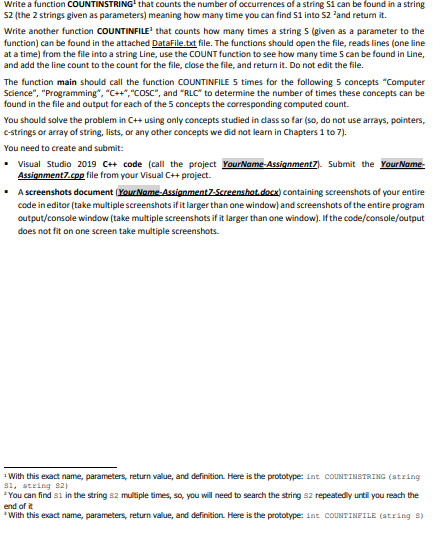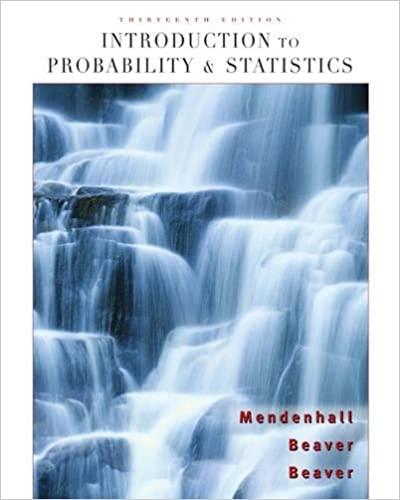Answered step by step
Verified Expert Solution
Question
1 Approved Answer
DataFile.txt DALLAS COLLEGE RICHLAND CAMPUS COMPUTER SCIENCE https://www.dcccd.edu/cd/credit/computer-science/pages/default.aspxComputer ScienceComputer science is the study of computers and computational systems. A discipline including theory and practice, it

DataFile.txt
DALLAS COLLEGE RICHLAND CAMPUS COMPUTER SCIENCE https://www.dcccd.edu/cd/credit/computer-science/pages/default.aspxComputer ScienceComputer science is the study of computers and computational systems. A discipline including theory and practice, it includes the study of methods for processing digital information, and the design of computer hardware and software along with the applications of computers. It requires thinking both in abstract and concrete terms. Computer science has a stronger foundation in math than in science.Computer science courses are listed under the four-letter rubrics (course prefixes) BCIS and COSC. Note that all courses may not be offered at every Dallas College campus.Guided Pathways are maps that show you what classes you will take, and when. View Guided PathwaysWhich classes are available?How much money will it cost?Will these classes transfer? At These Campuses:BrookhavenCedar ValleyEastfieldEl CentroMountain ViewNorth LakeRichlandhttps://www.dcccd.edu/cd/credit/computer-science/rlc/pages/default.aspxComputer Science at RichlandThe Computer Science program at Richland is committed to maintaining and offering up-to-date courses in the CIS field. The program offers online and live classes, and students will work with instructors to find closure on concepts and applications.https://www1.dcccd.edu/Cat20-21/coursedescriptions/detail.cfm?loc=RLC&course=COSC2020 - 2021 CatalogCourse Descriptions for COSCCourse Description Index | Degree PlansCourse Description Help PageCourse Number: COSC 1301 (3 Credit Hours)Listed by Campus(es): BHC, CVC, EFC, ECC, MVC, NLC, RLCCourse Title:Introduction to ComputingThis is a Texas Common Course Number.Course Description: Overview of computer systems hardware, operating systems, and microcomputer application software, including the Internet, word processing, spreadsheets, presentation graphics, and databases. Current issues such as the effect of computers on society, and the history and use of computers in business, educational, and other modern settings are also studied. This course is not intended to count toward a student''s major field of study in business or computer science. This course will fulfill degree requirements established by the colleges of DCCCD only if this course has been successfully completed and the date of completion does not exceed 10 years. (2 Lec., 2 Lab.)Coordinating Board Academic Approval Number 1101015107Search for COSC 1301 classesCourse Number: COSC 1315 (3 Credit Hours)Listed by Campus(es): BHC, EFC, ECC, MVC, RLCCourse Title:Introduction to Computer ProgrammingThis is a Texas Common Course Number.Course Description: Introduction to computer programming for solving a variety of problems. This course is intended for non-computer science and non-computer engineering majors. Emphasis on the fundamentals of design, development, testing, implementation, and documentation of computer programs. Includes problem solving with structured techniques and algorithms using pseudo code and/or graphical representations. This course may use instructional examples and assignments from various programming languages, including but not limited to C, Objective-C, C++, C##, and/or Java. COSC 1315 will satisfy the Associate of Science degree general elective requirement. This course will fulfill degree requirements established by the colleges of DCCCD only if this course has been successfully completed and the date of completion does not exceed 10 years. (3 Lec., 1 Lab.)Coordinating Board Academic Approval Number 1102015207Search for COSC 1315 classesCourse Number: COSC 1420 (4 Credit Hours) New course added April 5, 2020Listed by Campus(es): BHC, CVC, EFC, ECC, MVC, NLC, RLCCourse Title:C ProgrammingThis is a Texas Common Course Number.Course Description: Introduces the fundamental concepts of structured programming in the C language. Topics include data types; control structures; functions, structures, arrays, pointers, pointer arithmetic, unions, and files; the mechanics of running, testing, and debugging programs; introduction to programming; and introduction to the historical and social context of computing. (3 Lec., Lab.)Coordinating Board Academic Approval Number 1102015207Search for COSC 1420 classesCourse Number: COSC 1436 (4 Credit Hours)Listed by Campus(es): BHC, CVC, EFC, ECC, MVC, NLC, RLCCourse Title:Programming Fundamentals IThis is a Texas Common Course Number.Course Description: This course introduces the fundamental concepts of structured programming, and provides a comprehensive introduction to programming for computer science and technology majors. Topics include software development methodology, data types, control structures, functions, arrays, and the mechanics of running, testing, and debugging. This course may use instructional examples and assignments form various programming languages including but not limited to C, Objective-C, C++, and/or Java. This course assumes computer literacy. (This course is included in the Field of Study Curriculum for Computer Science.) COSC 1436 will satisfy the Associate in Sciences degree general elective requirement. This course will fulfill degree requirements established by the colleges of DCCCD only if this course has been successfully completed and the date of completion does not exceed 10 years. (3 Lec., 3 Lab.)Coordinating Board Academic Approval Number 1102015507Search for COSC 1436 classesCourse Number: COSC 1437 (4 Credit Hours)Listed by Campus(es): BHC, CVC, EFC, ECC, MVC, NLC, RLCCourse Title:Programming Fundamentals IIThis is a Texas Common Course Number.Prerequisite Required: COSC 1436 and MATH 1314 or higher.Course Description: This course focuses on the object-oriented programming paradigm, emphasizing the definition and use of classes along with fundamentals of object-oriented design. The course includes basic analysis of algorithms, searching and sorting techniques, and an introduction to software engineering processes. Students will apply techniques for testing and debugging software. This course may use instructional examples and assignments form various programming languages including but not limited to C, Objective-C, C++, and/or Java. (This course is included in the Field of Study Curriculum for Computer Science.) COSC 1437 will satisfy the Associate in Sciences degree general elective requirement. This course will fullfill degree requirements established by the colleges of DCCCD only if this course has been successfully completed and the date of completion does not exceed 10 years. (3 Lec., 3 Lab.)Coordinating Board Academic Approval Number 1102015607Search for COSC 1437 classesCourse Number: COSC 2425 (4 Credit Hours)This course is not currently offered by Richland Campus.Listed by Campus(es): BHC, ECC, NLCCourse Title:Computer OrganizationThis is a Texas Common Course Number.Prerequisite Required: COSC 1436.Course Description: The organization of computer systems is introduced using assembly language. Topics include basic concepts of computer architecture and organization, memory hierarchy, data types, computer arithmetic, control structures, interrupt handling, instruction sets, performance metrics, and the mechanics of testing and debugging computer systems. Embedded systems and device interfacing are introduced. (This course is included in the Field of Study Curriculum for Computer Science.) COSC 2425 will satisfy the Associate in Sciences degree general elective requirement. This course will fullfill degree requirements established by the colleges of DCCCD only if this course has been successfully completed and the date of completion does not exceed 10 years. (3 Lec., 3 Lab.)Coordinating Board Academic Approval Number 1102015407Search for COSC 2425 classesCourse Number: COSC 2436 (4 Credit Hours)Listed by Campus(es): BHC, EFC, ECC, MVC, NLC, RLCCourse Title:Programming Fundamentals IIIThis is a Texas Common Course Number.Prerequisite Required: COSC 1437.Course Description: Further applications of programming techniques, introducing the fundamental concepts of data structures and algorithms. Topics include recursion, fundamental data structures (including stacks, queues, linked lists, hash tables, trees, and graphs), and algorithmic analysis. This course may use instructional examples and assignments from various programming languages, including but not limited to C, Objective-C, C++, C#, and/or Java. COSC 2436 will satisfy the Associate in Sciences degree general elective requirement. This course will fulfill degree requirements established by the colleges of DCCCD only if this course has been successfully completed and the date of completion does not exceed 10 years. (3 Lec., 3 Lab.)Coordinating Board Academic Approval Number 1102015707Search for COSC 2436 classesACGM (Lower-Division Academic Course Guide Manual) CoursesDesignated by the Texas Higher Education Coordinating Board for general academic transfer among community, state, and technical colleges in Texas; and state public four-year colleges and universities as freshman and sophomore general education courses.WECM (Workforce Education Course Manual) CoursesDesignated by the Texas Higher Education Coordinating Board as workforce education (technical) courses offered for credit and CEUs (Continuing Education Units). While these courses are designed to transfer among state community colleges, they are not designed to automatically transfer to public four-year colleges and universities.Course Description Index | Degree PlansCourse Description Help Page
PLEASE HELP ME WITH THIS AND USE BEGINNER C++ CODES(donot use arrays, pointers, c-strings or array of string, lists, orany other concepts we did not learn in Chapters 1 to 7). Pleasetell me specifically what more information you want to do thisAssignment.
Write a function COUNTINSTRING that counts the number of occurrences of a string 51 can be found in a string S2 (the 2 strings given as parameters) meaning how many time you can find 51 into 52 and return it. Write another function COUNTINFILE that counts how many times a string 5 (given as a parameter to the function) can be found in the attached Datafile.txt file. The functions should open the file, reads lines (one line at a time) from the file into a string Line, use the COUNT function to see how many time 5 can be found in Line, and add the line count to the count for the file, close the file, and return it. Do not edit the file. The function main should call the function COUNTINFILE 5 times for the following 5 concepts "Computer Science", "Programming", "C++","COSC", and "RLC" to determine the number of times these concepts can be found in the file and output for each of the 5 concepts the corresponding computed count. You should solve the problem in C++ using only concepts studied in class so far (so, do not use arrays, pointers, c-strings or array of string, lists, or any other concepts we did not learn in Chapters 1 to 7). You need to create and submit: Visual Studio 2019 C++ code (call the project YourName-Assignment7). Submit the Your Name- Assignment7.cpp file from your Visual C++ project. A screenshots document (Your Name-Assignment 7-Screenshot.docx) containing screenshots of your entire code in editor (take multiple screenshots if it larger than one window) and screenshots of the entire program output/console window (take multiple screenshots if it larger than one window). If the code/console/output does not fit on one screen take multiple screenshots. With this exact name, parameters, return value, and definition. Here is the prototype: int COUNTINSTRING (string 31, string 82) *You can find s1 in the string s2 multiple times, so, you will need to search the string s2 repeatedly until you reach the end of it *With this exact name, parameters, return value, and definition. Here is the prototype: int COUNTINFILE (string S)
Step by Step Solution
★★★★★
3.30 Rating (153 Votes )
There are 3 Steps involved in it
Step: 1
implementation of these functions using beginnerlevel C concepts cpp Copy code include include inclu...
Get Instant Access to Expert-Tailored Solutions
See step-by-step solutions with expert insights and AI powered tools for academic success
Step: 2

Step: 3

Ace Your Homework with AI
Get the answers you need in no time with our AI-driven, step-by-step assistance
Get Started


